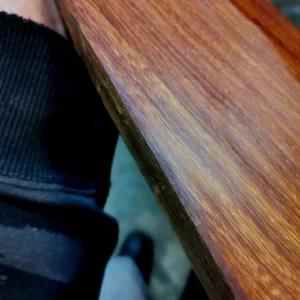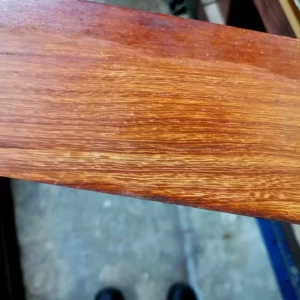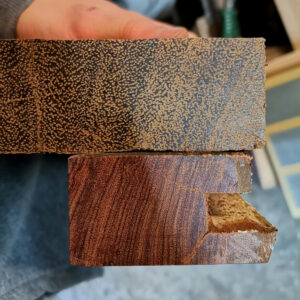Hello all! I’m new over here (and relatively new to woodworking as well 😅) and I was trying to get some help regarding the following subject: a friend of mine gave me a couple of old window cases that I recently dismantled and, after scraping one of them, I was intrigued since it looks like a somewhat “exotic” wood, but I most definitely can’t identify what it is. I dwelled into this Hobbithouse website, but I found images that look similar to this wood in various species as Macacaúba, Ipê or even Rosewood. I attached three pics, could someone help me identify this (in the last pic, I’m holding a piece of sucupira on top to compare the endgrain)? If it is of any help, I live in Portugal, so there’s a chance this might be from Brazil or even a southern African country…
Thanks in advance to you all!
Best regards,
Fábio
Discussion Forum
Get It All!
UNLIMITED Membership is like taking a master class in woodworking for less than $10 a month.
Start Your Free TrialCategories
Discussion Forum
Digital Plans Library
Member exclusive! – Plans for everyone – from beginners to experts – right at your fingertips.
Highlights
-
Shape Your Skills
when you sign up for our emails
This site is protected by reCAPTCHA and the Google Privacy Policy and Terms of Service apply. -
 Shop Talk Live Podcast
Shop Talk Live Podcast -
 Our favorite articles and videos
Our favorite articles and videos -
E-Learning Courses from Fine Woodworking
-
-
 Fine Woodworking New England Event
Fine Woodworking New England Event -















Replies
Sure looks like Ipe, notice the two wood colors from the same batch, one greenish and one teak like. This is from my wood pile :
Many thanks for your answer! From the images I checked before, Ipê actually was one of those who seemed to have more similarities to what I have... I was also checking Terry Porter's book on wood identification and he mentions that Ipê is/was applied in exterior construction and exterior floor decking so, since these were old window cases, it might make some sense.
Looks like Brazilian Tulipwood to me. If you have a scale and the stock is dry you can go to wood-database.com and get the average dried weight to see if you're in the ballpark.
Many thanks for your answer! I never heard of brazilian tulipwood before, but now that I saw a couple of images, it's actually strikingly similar. I guess I'll follow your advice, I'll try to cut a fairly squared small piece and make the calculations.
Tulipwood floats, Ipe sinks, put a chip in a bucket and find out what it does.
Witch!!!!
:-)
Well, that's a great tip. I could have thought of that earlier, since Ipê has a specific gravity superior to one... Many thanks yet again!
I had flooring in years back called "Brazilian Rosewood", probably a marketing name, but I kept the pallets and the look is exactly what the middle pic looked like. The endgrain looks too red for Ipe to me.
Well, these ones were covered in old varnish and probably it has some effect on coloration... And I also saturated the photo a tad bit, so it might help to make the endgrain look slightly reddish. Many thanks for your suggestion as well!
Hello all! Still haven't tried to prepare a piece of stock with proper measures so I can check the weight, but I tried the method suggested by Gulfstar and it seems it's actually Ipê. As you can see in the images attached, the very small piece actually floated, but the bigger one (more or less the size of my hand) just sank like titanic. Again, many thanks to everyone who tried to help!
So not a witch. The oddity of the test was always that being vindicated as a non-witch meant you had to drown.
You win some, you lose some.
“[Deleted]”
This is very similar to Ipe!
This forum post is now archived. Commenting has been disabled